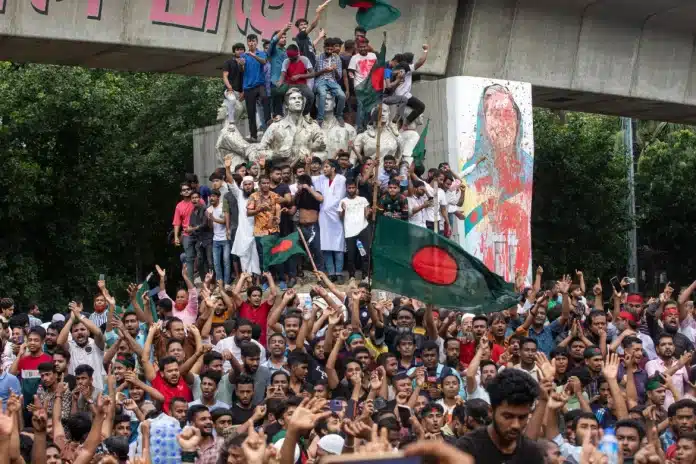Sheikh Hasina, Bangladesh’s longest-standing dictator, has been ousted, putting an end to her regime characterized by human rights violations and electoral fraud.
In its efforts to rebuild the nation, Bangladesh’s interim government must restore the hopes of its youth and ethnic minorities while addressing the army’s command responsibility. In its foreign policy, Bangladesh must confront perceptions of India as tied to Hasina’s Awami League and look to Western allies for support in reform.
Bangladesh, nestled at the mouth of the strategically important Bay of Bengal, has ousted its dictator without any foreign help. The South Asian nation of 171 million is often overlooked because of its small landmass. For decades, the West has turned a blind eye while former prime minister Sheikh Hasina and her party, the Awami League (AL), rigged one general election after another in what became the Indian subcontinent’s longest dictatorship.
During Hasina’s rule, human rights and the rule of law took a back seat. The Directorate General of Forces Intelligence — the Bangladesh Armed Forces’ defence intelligence agency — ran secret detention centres and Hasina’s government put five million members of the opposition on trial — the equivalent of the entire population of Ireland. Before she was ousted in a mass upsurge and fled to India in a military cargo plane, her government killed 542 people in 18 days, 65 of whom were children.
One reason why Hasina was able to cling onto power for so long was because she enjoyed India’s unwavering support for her regime. The Indian establishment’s friendship with the AL has a long history — during Bangladesh’s Independence War in 1971, India provided the AL-led Bangladesh government in exile with military and diplomatic support.
India also has security and strategic concerns when it comes to Bangladesh. Northeastern India, which is eight per cent of the country’s landmass, is landlocked and connected to the mainland through the 20 kilometre-long Siliguri Corridor, also called the Chicken’s Neck. This part of the country consists of seven insurgency prone states that share their border with Bangladesh, Nepal, Bhutan, Burma and China. Hasina’s regime made sure that these insurgent groups could not take shelter in Bangladesh by pushing their leaders back to India.
India returned the favour by supporting Hasina at home and abroad. Between 2022 and 2024, the United States made several attempts to punish human rights violators in Bangladesh. But India lobbied Washington to tone down its criticism of the regime in Dhaka, stating that India would not be ‘[taken] … as a strategic partner’ without ‘some kind of strategic consensus’ on Bangladesh. Faced with Indian pressure, the Biden administration softened its tone and in post-Hasina Bangladesh, runs the risk of being seen as a paper tiger.
READ ALSO:
EU to discuss Israel ties after ‘attacks’ on UN mission in Lebanon
The biggest loser in Bangladesh’s ‘Second Independence’ is India. Ordinary Bangladeshis are understandably struggling to separate India from Hasina’s Awami League. On the day of her fall, the Indira Gandhi Cultural Centre — the seat of India’s soft power in Bangladesh — was torched. The building was the only foreign establishment attacked in the uprising.
Protesters roamed the streets of the capital and pulled down statues of Sheikh Mujibur Rahman, Hasina’s father, who the former prime minister occasionally used to shore up support. There have been indiscriminate cases of robbery and looting. Homes of minority Hindus and their places of worship have been attacked.
The question of the role of the Islamists in Bangladesh’s future democratic polity is a thorny issue. In late August 2024, the interim government, led by Nobel laureate Muhammad Yunus, lifted a ban on Bangladesh’s Jamaat-e-Islamiparty that Hasina’s administration imposed for its alleged involvement in terrorism. The Islamists, albeit a vocal minority, never won more than 22 seats in a 300 member parliament.
In August 2024 Jasimuddin Rahmani, leader of the Ansarullah Bangla Team (ABT), was released on bail. The ABT shares its ideology with Al Qaeda and was banned by the government in 2015. Even though the ABT represents a fringe element in Bangladesh, it is capable of taking advantage of any power vacuum that may emerge.
Bangladesh’s new government has a lot on its plate. To confront the nation’s violent past, it should open an office of missing persons to investigate cases of enforced disappearances. It should also help with an independent commission run by the United Nations to probe into human rights violations committed in the lead up to Hasina’s ousting.
To prevent future dictatorships and coups d’etat in a country with a history of overambitious generals, it is necessary to form a special tribunal to determine command responsibility. Officials of the Bangladesh Armed Forces who were deployed to quell the protests should be stripped of any command responsibility in the army. Those in the army who shot at people’s peaceful protest must face trial.
The Rapid Action Battalion and the Director General of Forces Intelligence must be disbanded. Some members of the armed forces were evidently involved in crimes against humanity as torture cells inside the Dhaka Cantonment have been found. The United Nations should put a moratorium on hiring members of the Bangladesh Armed Forces in its peacekeeping missions until trials of Bangladesh army officials involved in crimes against humanity begin.
An overhaul of Bangladesh’s police and judiciary is the order of the day. Bangladesh needs a new constitution that will reflect the hopes and aspirations of its young people and all ethnic minorities. The United States, Australia and Bangladesh’s other Western partners can redeem themselves by helping the country in its rebuilding efforts.













